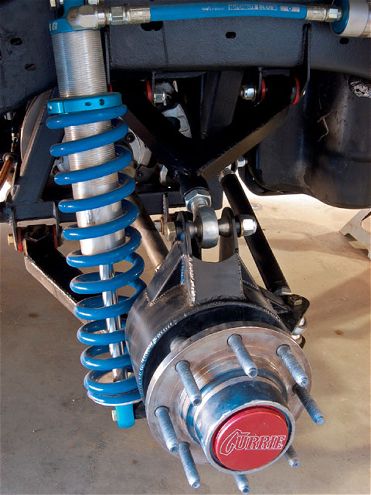Well, here's the new plan, I'm gonna start writing tech every other month and tell tales of the shop owners the other months. To make things easier in the future, we're going to define some technical terms. Simply cut this page out (hopefully there isn't anything cool on the other side), put it in a binder, and start your own technical book of suspension stuff.
Bump: When the suspension is traveling up toward the truck (lowering the truck), it is "going into bump."
Droop: When the suspension is traveling down away from the truck (lifting the truck), it is "drooping out."
Full Bump: When the suspension is completely collapsed, or the truck is laid all the way out, it is at "full bump."
Full Droop: When the suspension is completely lifted, or "topped out," it is at "full droop."
Valving: Also loosely called "dampening," it is the term used to describe a shock's ability to dampen or absorb shock. Stiffer valving would be a shock that is harder to move and softer valving would be easier to move.
Compression: Another term for "bump," but typically used for describing a shock. When a shock is being collapsed, it is being compressed.
Compression Valving: Describes the shock's valving when being shortened.
Rebound Valving: This describes the shock's valving when being lengthened.
Spring Rate: A measurement given to a spring, even an air spring, that is typically pounds per square inch. If a spring is a 300-pound spring, it takes 300 pounds to collapse the spring one inch, and another 300 pounds to collapse the spring another inch, and so on. For example, a 200-pound spring with 1,200 pounds applied to it will collapse six inches.
Wheel Rate: The spring rate is rarely what is seen at the wheels, because the spring is typically leveraged on an A-arm or link bar of some sort, so the ratio would be calculated out to come up with a wheel rate. Both springs and shocks are changed by leverage points, and would be different at the wheel.
These terms are semi-basic, but should be at least understood when a person is delving deeper into suspension design. There are several different terms, which are commonly used by other automotive enthusiasts to describe some of these concepts, but these are the basics. As time goes by, we will add to this. So, leave room in your "book" for more terms.

| truck Term Glossary shocks
This is far from a minitruck, but it's a good example of spring rate, shock rate, compression, and rebound dampening, wheel rate, and full droop. This vehicle had to ride as nice as possible while sitting at a specific height. In a situation like that, you would reverse the calculations to find the spring rate to use. When ordering high-end shocks, they will take all of your basic dimensions and build the shocks with best-guess valving and the closest spring to the rate that had been calculated. Then, you would need to drive the vehicle to determine if the shocks need more or less spring rate, and or rebound and compression valving. Also, the suspension is at full droop when on jackstands.
 | truck Term Glossary shocks
This is far from a minitruck, but it's a good example of spring rate, shock rate, compression, and rebound dampening, wheel rate, and full droop. This vehicle had to ride as nice as possible while sitting at a specific height. In a situation like that, you would reverse the calculations to find the spring rate to use. When ordering high-end shocks, they will take all of your basic dimensions and build the shocks with best-guess valving and the closest spring to the rate that had been calculated. Then, you would need to drive the vehicle to determine if the shocks need more or less spring rate, and or rebound and compression valving. Also, the suspension is at full droop when on jackstands.
| truck Term Glossary shocks
This is far from a minitruck, but it's a good example of spring rate, shock rate, compression, and rebound dampening, wheel rate, and full droop. This vehicle had to ride as nice as possible while sitting at a specific height. In a situation like that, you would reverse the calculations to find the spring rate to use. When ordering high-end shocks, they will take all of your basic dimensions and build the shocks with best-guess valving and the closest spring to the rate that had been calculated. Then, you would need to drive the vehicle to determine if the shocks need more or less spring rate, and or rebound and compression valving. Also, the suspension is at full droop when on jackstands.